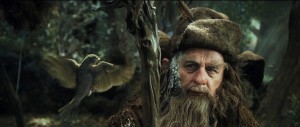 If those first three seconds of the ninth production video for The Hobbit don’t grab your attention, nothing will.
If those first three seconds of the ninth production video for The Hobbit don’t grab your attention, nothing will.
It’s illustrative of Jackson’s ability to convey a great deal in just a few short moments.
Although it’s not our first glimpse of Radagast, nor of Radagast communing with an animal, it is our first video glimpse of Radagast communicating with a bird (click for HD screencap).
This may seem unimportant, but consider that in Unfinished Tales (UT) Christopher Tolkien remarks that Radagast’s Quenya name, Aiwendil, ‘must mean “lover of birds”.’ Now, as much as the film-makers are legally unable to use the material from UT and the like, they surely must have read it at some point.
And consider the deep affection and respect for the creature that the actor, Sylvester McCoy, as he says “Show me.” conveys with his face and his tone of voice in just those few brief moments.
For those who are concerned about thematic fidelity to Tolkien (all of us, surely!), this is a reassuring.

For, in Middle-earth, the little things are just as important as the big things. Indeed, it’s the attention to (and, paradoxically, the simultaneous haziness of) the tiny details that gives Tolkien’s Middle-earth its lived-in feel.
Now, at first I assumed that the bird that Radagast is communicating with here is a hummingbird.
It hovers. Hummingbirds hover. Ergo, it must be a hummingbird. Right?
Not so. A birder friend who knows about hummingbirds tells me it is most definitely not a hummingbird.
So, what is it? (to steal a famous Red Dwarf quote)
Well, apparently hummingbirds aren’t the only avian species that can hover, as it turns out. They are, of course, the most well-known of hovering birds, due to their vivid colouration.
In fact, it turns out that some species of thrush can also hover. You can Google this for yourselves.
But maybe it’s too big to be a thrush? Tolkien tells us that the thrush of Middle-earth were particularly large.
There on the grey stone in the grass was an enormous thrush, nearly coal black, its pale yellow breast freckled with dark spots. Crack! It had caught a snail and was knocking it on the stone. Crack! Crack! The Hobbit, Chapter 11. On The Doorstep.
But what about that colouration? I dunno, what about this?
So, I’m thinking it’s, perhaps, a thrush.
EDIT: The consensus seems to be that it’s an American Robin. Turdus migratorius is a migratory songbird of the thrush family [emphasis added]. It is named after the European Robin because of its reddish-orange breast, though the two species are not closely related, with the European robin belonging to the flycatcher family. Thanks to all on Barliman’s and the Messageboards who contributed to the ID hunt.
Or watch the vid below and draw your own conclusions.
Now here’s the key bit.
Even if (as seems very likely) it is a thrush, it’s equally unlikely that this will be the thrush that plays such a key role in the Company’s quest. (For those of you who are unaware, or who have forgotten, the thrush is mentioned on the Map of Thror and is the inspiration for Bilbo learning how to open the secret door. The thrush also brings news of Smaug’s vulnerability to Bard the Lake-man. Bard uses this knowledge to slay Smaug with the Black Arrow.
I feel the presence of this thrush indication that we will see the real thrush guiding Bilbo and Bard in one of the later films.
And for readers who enjoy the little beauties of Tolkien’s The Hobbit, and wish to see that recreated in film, that’s a comforting thing.
The views in this post are the author’s own, and do not necessarily represent those of TheOneRing.net or its staff.


